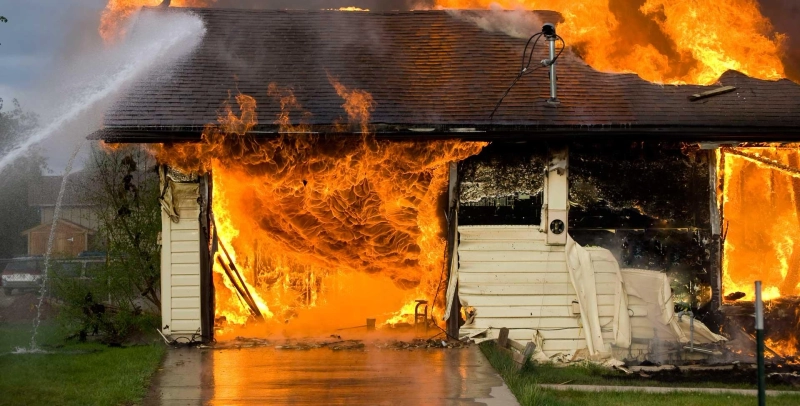The physical damage caused by fire to a building structure is referred to as fire damage. This damage might be inflicted directly by the fire flames or by smoke and other corrosive chemicals released by the fire. As we all know the fire can be a traumatic event, and the prospect of repairing fire-damaged belongings can be daunting. Fire wreaks havoc on property like no other natural calamity. It is frequently severe and causes a slew of issues that disrupt daily life and take a lot of time for restoration. When it comes to property repair, it is important to work as quickly as feasible to avoid more damage and to save money. The process of restoring fire and smoke-damaged buildings to their pre-loss state is known as fire damage restoration. The restoration process normally requires weeks or months depending upon the disaster it occurs. As compared to the fire damage the water damage restoration will last only for a day or sometimes last for hours. The fire damage restoration involves property board up, demolition and reconstruction may be required, in addition to activities such as debris, odour and soot removal, contents cleaning, and working to remove any damaged dangers such as lead and asbestos. The restoration process varies according to the depth of the fire that catches up inside the property. Before the fire damage restoration professional enters into the premises to examine the amount of the fire damage that occurred and to calculate the restoration process time-bound we must first obtain the formal go-ahead from a licensed organization or from the concerned department. Otherwise, a contractor may enter a dangerous environment and the risk of getting injury is very high. After getting the clearance certificates the fire restoration team will inspect the damage sustained in the fire and ensuing water intrusion. The evaluation focuses on how deep the flames and smoke have entered the structure and how extensive any clean-up will be. This survey is primarily concerned with determining what should be eliminated and what may be packed out and recovered. After ending up the assessment process the next step is to secure the damaged property. Remove any debris from the inside and surrounding regions. If there is any damage to the roof, create a temporary arrangement by tarping or sealing off sections of the roof to protect the undamaged property from the weather. Install a fence around the damaged area of the property to keep it safe and secure. If certain sections of the property were not affected by the fire, restoration specialists must ensure that these areas are separated from the affected areas to avoid cross-contamination. At this point, the restoration crew is primarily concerned with preventing future damage from mould or corrosion by removing water and cleaning out the moisture content in the property. The personal belongings are cleared off from the interior of the facility. The damaged drywall, flooring, and other components will be removed directly to the studs. To dry out the building, water extraction teams will use commercial equipment. Roof coverings will be secured throughout this stage to prevent future water incursions. This section is mostly concerned with the restoration and cleaning processes. Professionals remove smoke and soot from interior and outdoor surfaces. If the damage is severe enough, every inch of the damaged area must be cleansed. If water damage restoration was also conducted, it may be essential to disinfect the area or use antimicrobial treatments to prevent further mould growth. Duct cleaning is also part of the cleanup process to remove any soot, smoke, or debris that has accumulated in the ducts. This might be the final and last step in the restoration process as a result the property will be received in a pre-loss condition after repairing or rebuilding the fire-damaged areas. After the occurrence of fire, portions of the structure may be entirely unsalvageable and must therefore be demolished and replaced. To restore the property to a pre-loss state, the replacement may involve rebuilding and replacing the roof structure, restoring electricity, replacing, repairing and painting walls, changing flooring materials or filling cracked areas, replacing interior counters and fixtures, and so on. Availability of 24-hour service: Fire damage is an unforeseeable calamity that can cause significant harm if not repaired on time. Their service is available every day of the week, month, and year Quick response: Fire restoration service providers will arrive quickly, giving you a speedy and efficient solution to your situation. Various approaches and cutting-edge equipment will be employed to resolve the issues and restore the property to its pre-fire form. Experienced and qualified: Professionals that have received training and have years of expertise will provide the service in a quality manner with rapid outcomes. When it comes to choosing a restoration service, knowing what to do is critical. An expert specialist among the team named supervisor will evaluate and analyze the damage before implementing the set strategy to return your property to its original shape.WHAT EXACTLY IS FIRE DAMAGE
What is Fire Damage Restoration?
Fire Damage Restoration Procedures
1. Assessment of Damage that Occurred
2.Debris Removal and Property Security
3.Water Mitigation, Demolition, and Drying Out
4.Cleaning & Smoke Elimination Process
5.Restoration & Remodeling
Benefits of hiring fire restoration services
WHAT EXACTLY IS FIRE DAMAGE AND HOW DOES RESTORATION WORK?


